Wrens are small, energetic songbirds that add life and sound to Texas’ diverse landscapes. Known for their loud and distinctive songs, these birds are often more easily heard than seen, flitting through shrubs, woodlands, and wetlands across the state.
Texas hosts a variety of wren species, ranging from the common Carolina Wren to rare visitors like the Gray-barred Wren. Each species has unique markings, behaviors, and habitat preferences, making them a delight for birdwatchers and nature enthusiasts alike.
In this guide, we explore 10 types of wrens found in Texas, including their identification, behaviors, songs, and the best locations and times to observe them. Whether you are a seasoned birder or a curious beginner, this guide will help you recognize and appreciate these fascinating birds.
Common Wrens Found in Texas
Carolina Wren (Thryothorus ludovicianus)
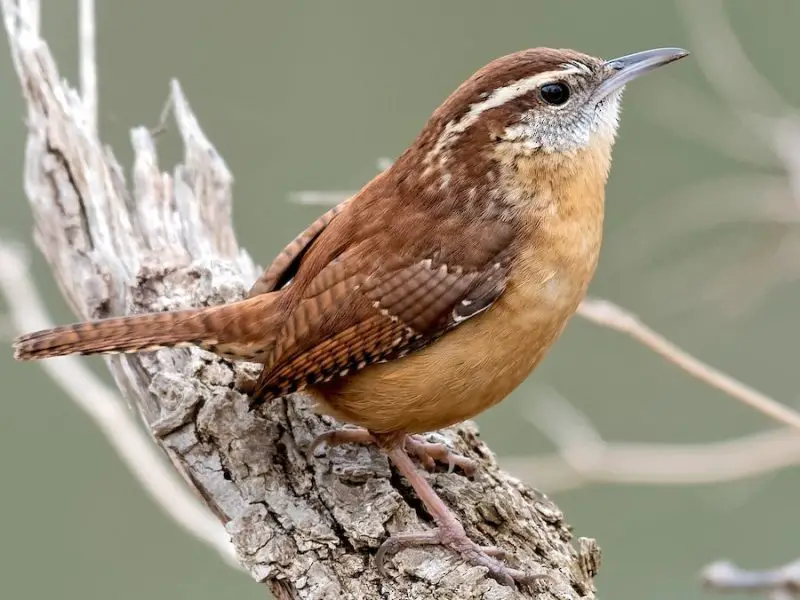
The Carolina Wren is a medium-sized songbird, measuring approximately 12–14 cm in length with a wingspan of 16–20 cm. It displays a warm reddish-brown coloration on its upperparts, with a lighter buffy underbelly and a distinctive white eyebrow stripe that is highly noticeable in the field. Its short, slightly curved bill is adapted for probing into crevices to find insects and spiders.
Carolina Wrens are easily identified by their loud, melodious, and repetitive song, often described as “teakettle-teakettle-teakettle.” They are highly vocal year-round, which makes them easier to detect than many other small birds. Their behavior includes perching upright and flicking their wings frequently, giving them a characteristic alert appearance.
In terms of habitat, Carolina Wrens are highly adaptable in Texas, ranging from woodlands and suburban gardens to brushy fields and riparian areas. They are non-migratory, maintaining territories throughout the year, and often nesting in tree cavities, abandoned structures, or artificial nest boxes.
These wrens are active foragers, hopping along branches and leaf litter while searching for insects, spiders, and occasionally small fruits. They display strong territorial behavior, with males defending their territory vigorously against intruders. Carolina Wrens can also be observed caching food and demonstrating remarkable problem-solving skills to access hidden prey.
Bewick’s Wren (Thryomanes bewickii)
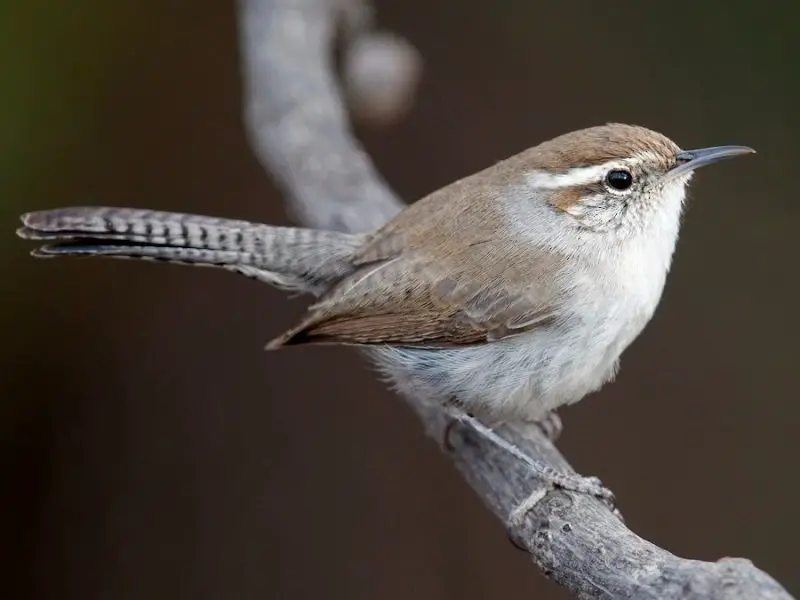
Bewick’s Wrens are small, slender wrens, about 11–13 cm in length with a wingspan of 16–19 cm. Their grayish-brown upperparts contrast with a pale, slightly streaked underbelly. One of the most distinctive field marks is the long, narrow white eyebrow stripe extending above the eye, along with a relatively long tail often cocked upward.
The song of the Bewick’s Wren is complex and variable, consisting of clear whistles, trills, and chatter. They are highly vocal during the breeding season, with males singing from exposed perches to establish territory. Behaviorally, these wrens are very active, often darting through shrubs or along fence lines, flicking their wings and tails as they move.
Bewick’s Wrens favor scrubby habitats, open woodlands, thickets, and suburban edges throughout Texas. They tend to avoid dense forests, preferring areas with ample perches and nesting opportunities in brush piles, tree cavities, or man-made structures. They are also non-migratory, remaining in their territories year-round.
These wrens primarily forage on insects and spiders, picking prey from foliage, bark, and even the ground. They are known for their agility, often hanging upside down on twigs or branches while searching for hidden insects. Their boldness allows them to explore human-modified environments while maintaining a cautious awareness of predators.
House Wren (Troglodytes aedon)
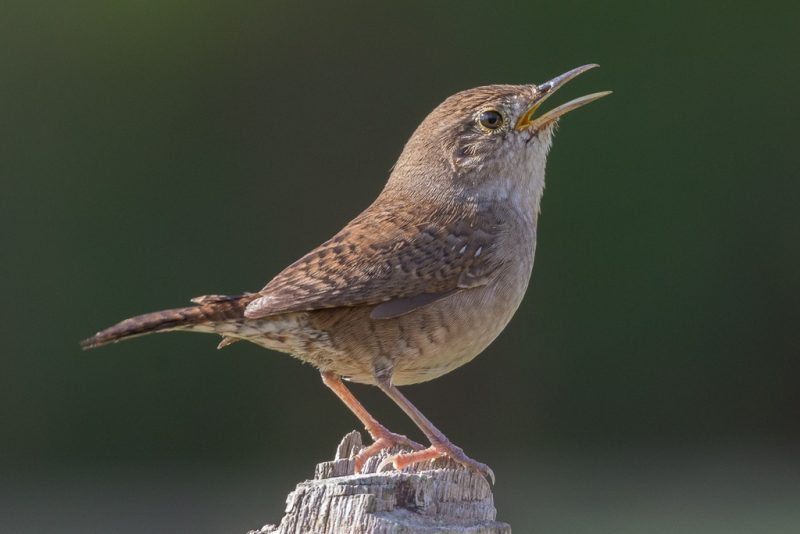
The House Wren is a small, energetic bird measuring around 10–12 cm in length with a wingspan of 15–17 cm. Its plumage is generally brown with faint barring on the wings and tail, and a paler, buffy underbelly. Unlike other wrens, it lacks prominent eyebrow markings, making its small size and behavior key identification clues.
House Wrens are noted for their bubbly, gurgling song, often delivered in rapid succession from exposed perches. They are extremely active and inquisitive, frequently hopping through shrubs, climbing fences, and investigating potential nesting cavities. Their behavior is characterized by constant movement and a restless energy.
In Texas, House Wrens inhabit open woodlands, suburban areas, gardens, and shrublands. They are cavity nesters, readily accepting nest boxes, old woodpecker holes, and other small crevices. These wrens are migratory in northern parts of their range, but many in Texas remain year-round, taking advantage of the mild winters.
House Wrens feed primarily on insects and spiders, gleaning them from leaves, branches, and the ground. They are highly territorial during breeding, aggressively defending nest sites from other wrens and small birds. Their adaptability allows them to thrive near human settlements, often taking advantage of feeders and ornamental plants.
Cactus Wren (Campylorhynchus brunneicapillus)
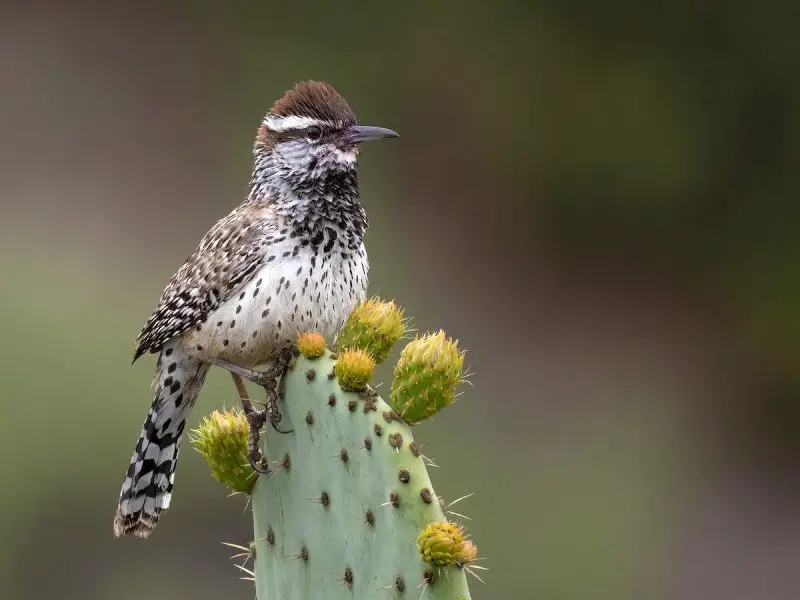
The Cactus Wren is one of the largest wren species in North America, measuring 18–22 cm in length with a wingspan of 25–30 cm. Its plumage features mottled brown and white patterns, providing excellent camouflage among desert shrubs and cacti. A prominent white eyebrow and speckled breast make this species unmistakable in the wild.
Its song is a loud, harsh series of whistles and churrs, often delivered from a high perch to mark territory. Cactus Wrens are highly conspicuous, displaying bold behavior, including rapid movements, hopping between cactus branches, and vocal displays. They are also known to use their strong bills to dig into cactus pads for nesting material.
In Texas, particularly in the southern and western deserts, Cactus Wrens favor arid scrublands, mesquite, and cholla cactus habitats. They are non-migratory and construct large, dome-shaped nests in cacti or thorny shrubs, which provide protection from predators. Their nests can house multiple breeding pairs in some cases, forming loose colonies.
These wrens feed mainly on insects, spiders, and occasionally small reptiles, foraging on the ground and in cactus branches. They are well-adapted to desert life, showing remarkable tolerance to high temperatures and scarce water. Their sharp eyesight and quick reflexes allow them to detect and evade predators, making them highly resilient desert dwellers.
Marsh Wren (Cistothorus palustris)
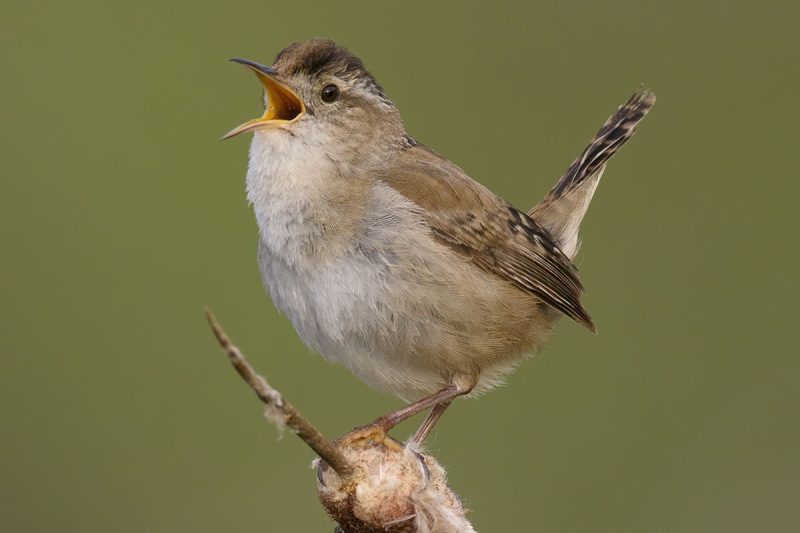
Marsh Wrens are small, about 10–12 cm in length with a wingspan of 15–18 cm, exhibiting brown and buff streaked plumage that blends perfectly with marsh vegetation. A distinctive feature is the blackish streak along the side of the head, contrasting with a paler throat and underparts. Their short, slender bill is well-suited for probing dense reeds.
Their vocalizations are complex, including bubbly trills, rattles, and warbles that echo through wetlands. Males are especially vocal during breeding season, often singing from reed stems or cattails to establish territory. These wrens are agile, capable of clinging to vertical reed stalks and making sudden short flights over water or marsh vegetation.
Marsh Wrens inhabit freshwater and brackish marshes across Texas, preferring areas with dense cattails, reeds, and emergent vegetation. They are migratory in northern ranges, but many in Texas overwinter locally. Nesting is unique: males often build multiple “dummy” nests to attract females, who then select one for breeding.
Their diet consists mainly of insects, spiders, and aquatic invertebrates, which they glean from reeds or capture in short flights. Marsh Wrens are highly territorial, with males engaging in vocal and physical displays to defend nesting areas. Their behavior and secretive habitats make them challenging to spot, despite their loud songs.
Sedge Wren (Cistothorus platensis)
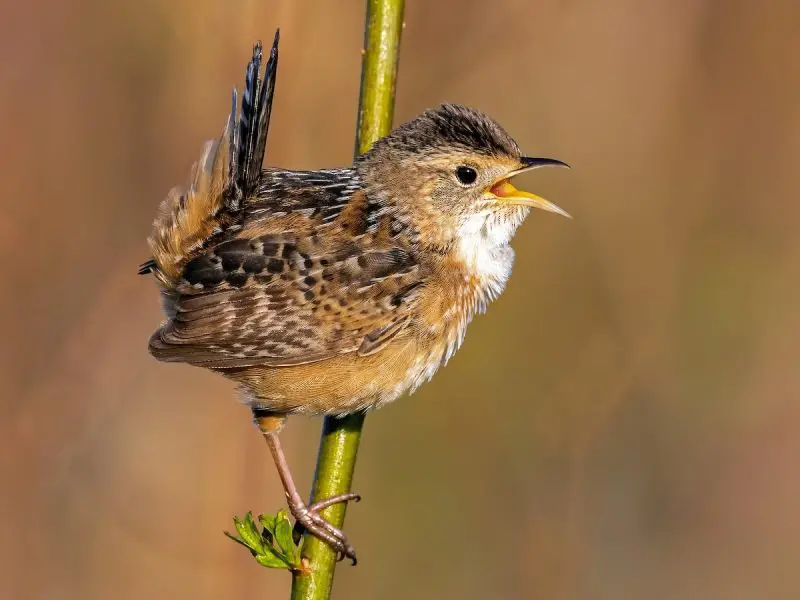
The Sedge Wren is a small, compact bird, measuring around 10–11 cm in length with a wingspan of 15–17 cm. Its plumage is a warm brown with subtle streaking on the back and a lighter, buffy underbelly. The crown is slightly darker, and its short, slender bill is perfect for probing dense marsh grasses and sedges.
Sedge Wrens are known for their bubbly, insect-like song, often delivered in rapid bursts from tall grasses. They are very secretive, frequently hopping through dense vegetation rather than perching openly. Their behavior includes flicking their tails upward and diving into thick sedge patches, making them challenging to spot.
In Texas, Sedge Wrens are typically found in marshes, wet meadows, and grasslands with tall, dense vegetation. They are migratory in much of their range, with Texas serving as a key wintering area for northern populations. Nests are constructed low in the grass, usually dome-shaped and well-hidden from predators.
These wrens feed primarily on insects, spiders, and other small invertebrates, gleaned from grasses and nearby vegetation. They are highly territorial during the breeding season, with males often singing from concealed perches to deter rivals. Despite their small size, they demonstrate remarkable agility and persistence when navigating dense marshy habitats.
Rock Wren (Salpinctes obsoletus)
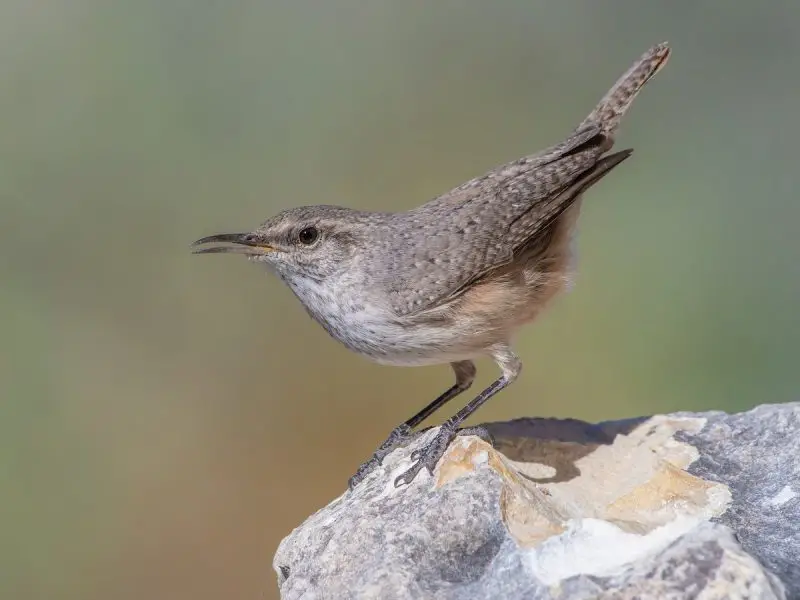
The Rock Wren is a medium-small wren, about 14–16 cm in length with a wingspan of 18–22 cm. Its plumage is pale gray-brown with fine streaking on the back and buff underparts. Notably, it has a long, slightly curved bill and relatively long legs, which aid in hopping among rocky terrain.
Its song is a series of high, musical trills and whistles, often delivered from exposed rock ledges. Behaviorally, Rock Wrens are bold and active, frequently hopping among boulders, cliff faces, and rocky slopes. They are skilled at navigating uneven surfaces while foraging for insects and spiders.
In Texas, Rock Wrens inhabit arid and semi-arid regions, including rocky canyons, cliffs, and outcrops, particularly in western and central areas. They are non-migratory residents in the state, constructing cup-shaped nests in rock crevices, abandoned cavities, or sometimes man-made structures.
Rock Wrens primarily feed on insects, spiders, and other arthropods found among rocks. Their alert, energetic movements and strong territorial instincts make them highly visible in their chosen habitat. They often display distinctive tail flicks and wing movements while foraging, a signature behavior of the species.
Winter Wren (Troglodytes hiemalis)

The Winter Wren is a small, rounded wren, about 9–10 cm in length with a wingspan of 13–16 cm. Its plumage is dark brown with fine barring on the wings and tail, and a pale buffy throat. A short, slightly curved bill complements its agile foraging style, while its stubby tail is usually held upright.
Winter Wrens are renowned for their loud, cascading song, delivered in a complex series of trills and rattles despite the bird’s tiny size. They are very active and secretive, often moving through dense undergrowth, leaf litter, and low shrubs in search of prey.
In Texas, Winter Wrens are uncommon migrants, typically passing through the state during late fall or early spring. They prefer dense woodlands, forest edges, and riparian habitats with plenty of cover for foraging. Nesting is rare in Texas, as they usually breed in northern coniferous forests.
These wrens feed primarily on insects, spiders, and other small invertebrates, often probing into leaf litter, moss, and crevices. Despite their small size, Winter Wrens are feisty and territorial, defending feeding areas and vocalizing persistently during migration stops. Their elusive nature makes them a challenge to observe in the wild.
Brown-throated Wren (Troglodytes brunneicollis)

The Brown-throated Wren is a small wren, around 10–11 cm in length with a wingspan of 14–16 cm. Its most distinctive feature is the rich brown coloration of its throat and upper chest, contrasting with paler underparts and lightly streaked wings. The subtle facial pattern helps distinguish it from other Troglodytes wrens.
Its song consists of a series of melodious trills and whistles, delivered in a clear, musical pattern. Behaviorally, Brown-throated Wrens are active and inquisitive, moving quickly through shrubs, thickets, and low tree branches. They flick their tails and wings frequently while foraging.
In Texas, this species is considered a rare migrant, mostly observed in southern regions during spring and fall. They favor brushy habitats, forest edges, and riparian zones, often remaining close to dense vegetation to avoid predators. Breeding occurs primarily farther south, outside of Texas.
Brown-throated Wrens feed mainly on insects and spiders, which they glean from leaves, twigs, and low vegetation. Their territorial instincts are noticeable when males vocalize to establish feeding or temporary resting areas. Despite being uncommon, their distinctive brown throat and lively song make them memorable for experienced birders.
Gray-barred Wren (Campylorhynchus griseus)
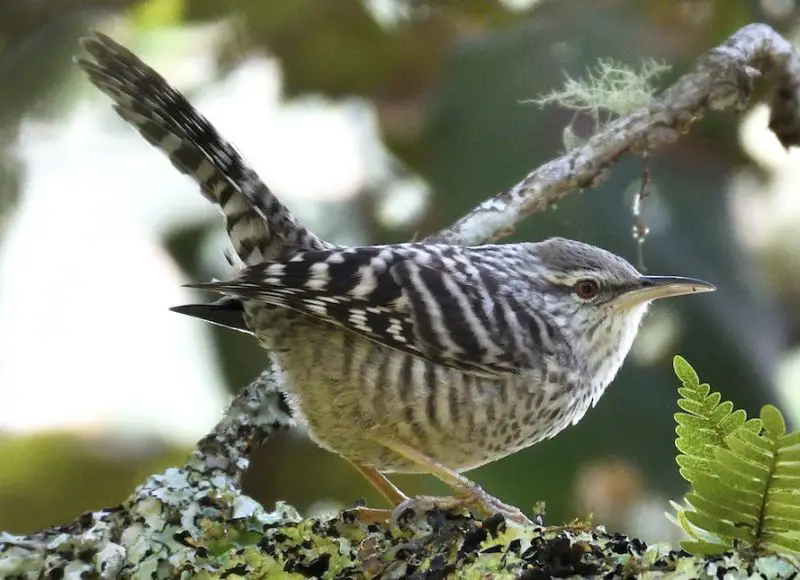
The Gray-barred Wren is a large wren species, measuring 18–20 cm in length with a wingspan of 25–28 cm. Its plumage is grayish-brown with distinct horizontal barring across the back and wings, providing excellent camouflage among shrubs. A pale eyebrow and speckled underparts further distinguish it from similar wrens.
Its song is loud and harsh, consisting of repeated trills, rattles, and whistles, often delivered from elevated perches to defend territory. These wrens are bold and active, hopping between branches and shrubs while searching for insects, seeds, and other small prey.
In Texas, Gray-barred Wrens are extremely rare, with only occasional sightings in the southernmost parts of the state. They inhabit semi-arid scrublands, thorn forests, and dense thickets, often remaining close to brushy cover. Nesting is uncommon in Texas and primarily occurs in their core range farther south.
Gray-barred Wrens feed primarily on insects, small invertebrates, and occasionally plant material. Their large size and striking barring make them stand out when observed, though their rarity means sightings are prized among birders. They exhibit strong territorial behavior, defending their chosen area with persistent vocalizations and active displays.
Best Time and Places to Observe Wrens in Texas
Observing wrens in Texas depends largely on the species, migration patterns, and preferred habitats. Carolina Wrens and Bewick’s Wrens are resident species and can be seen year-round, though spring and early summer are ideal when males sing actively and establish territories. They are commonly found in woodlands, suburban gardens, brushy fields, and scrubby areas, often perching visibly while foraging or calling early in the morning.
House Wrens are present year-round in southern Texas, but northern populations are migratory, appearing mainly in spring and summer. Gardens, parks, open woodlands, and shrublands with available nest cavities are the best locations, and early morning or late afternoon offers the highest activity levels.
Cactus Wrens, non-migratory residents of southern and western Texas, are most visible during spring and early summer, especially while defending territories and building nests. They favor arid scrublands, mesquite areas, and cactus thickets, particularly around cholla and prickly pear cacti. Observing from a safe distance is recommended due to their territorial behavior.
Marsh Wrens and Sedge Wrens are migratory species, with Texas serving as a wintering ground or stopover site. Marsh Wrens are best seen from late fall to early spring in freshwater and brackish marshes with dense cattails or reeds, while Sedge Wrens are more common during spring and fall in wet meadows and tall grasslands. Both species are often located by their distinctive songs early in the morning.
Rock Wrens are residents of western and central Texas, observable year-round, with spring and fall offering peak visibility. They inhabit rocky canyons, cliffs, outcrops, and arid hillsides, hopping between boulders while foraging for insects. Winter Wrens, Brown-throated Wrens, and Gray-barred Wrens are very rare migrants. Winter Wrens pass through dense woodlands and riparian zones in late fall and early spring, while Brown-throated Wrens are seen in southern brushy habitats during migration. Gray-barred Wrens appear occasionally in southern thorn forests and scrub areas, though sightings are extremely rare.
Early morning observation is generally the most productive for all wrens, as they are highly vocal and active at this time. Using careful listening for their songs and choosing habitats suited to each species significantly increases the chance of successful sightings.
FAQs about Wrens in Texas
What is the most common wren in Texas?
The most common wren in Texas is the Carolina Wren, which is a year-round resident across the state. Its loud, “teakettle-teakettle” song makes it one of the most recognizable wrens, often found in backyards, gardens, and wooded areas.
Are wrens in Texas migratory?
Some wrens in Texas are migratory, while others are permanent residents. Carolina Wrens, Bewick’s Wrens, Cactus Wrens, and Rock Wrens stay year-round. In contrast, House Wrens, Marsh Wrens, Sedge Wrens, and Winter Wrens are migratory, appearing seasonally during migration or wintering periods.
Where is the best place to see wrens in Texas?
The best place to see wrens depends on the species. Cactus Wrens are common in the deserts of west and south Texas, Marsh Wrens favor cattail wetlands, and Rock Wrens are found in rocky canyons and cliffs. More adaptable species like the Carolina Wren and House Wren are easily seen in suburban backyards and wooded edges across the state.
What do wrens eat in Texas?
Wrens primarily eat insects, spiders, and small invertebrates, which they glean from foliage, bark, and the ground. Some species, like the Carolina Wren, also consume berries and small fruits, especially in winter when insects are scarce.
When is the best time of day to observe wrens?
Wrens are most active in the early morning and late afternoon, when they forage energetically and sing to establish or defend territories. Birders will have the most success locating them by listening for their distinctive songs during these times.
Are any wrens in Texas considered rare?
Yes, a few wrens are considered rare in Texas. The Brown-throated Wren is a rare migrant, usually appearing in southern regions, while the Gray-barred Wren is an extremely rare visitor from farther south. Spotting these species is considered a special event for birders.






